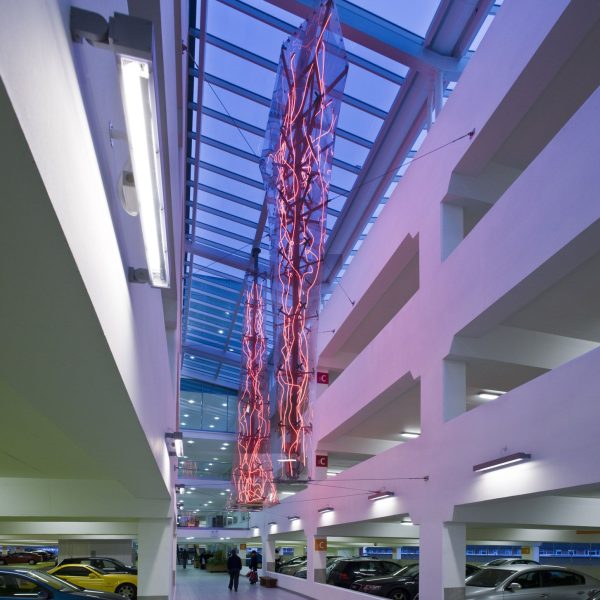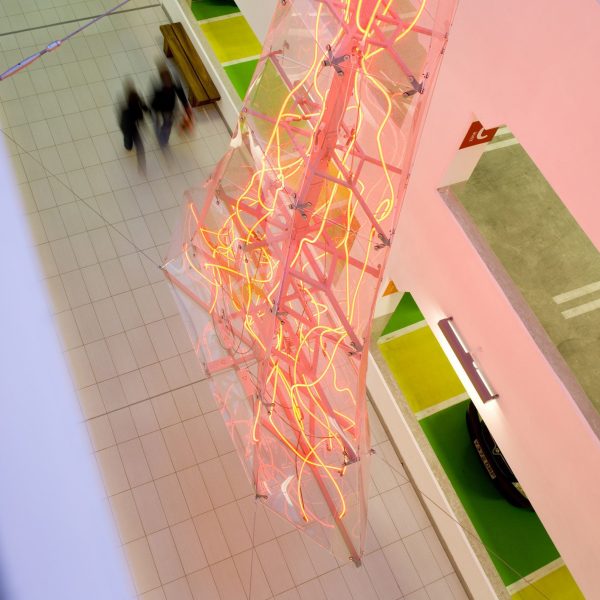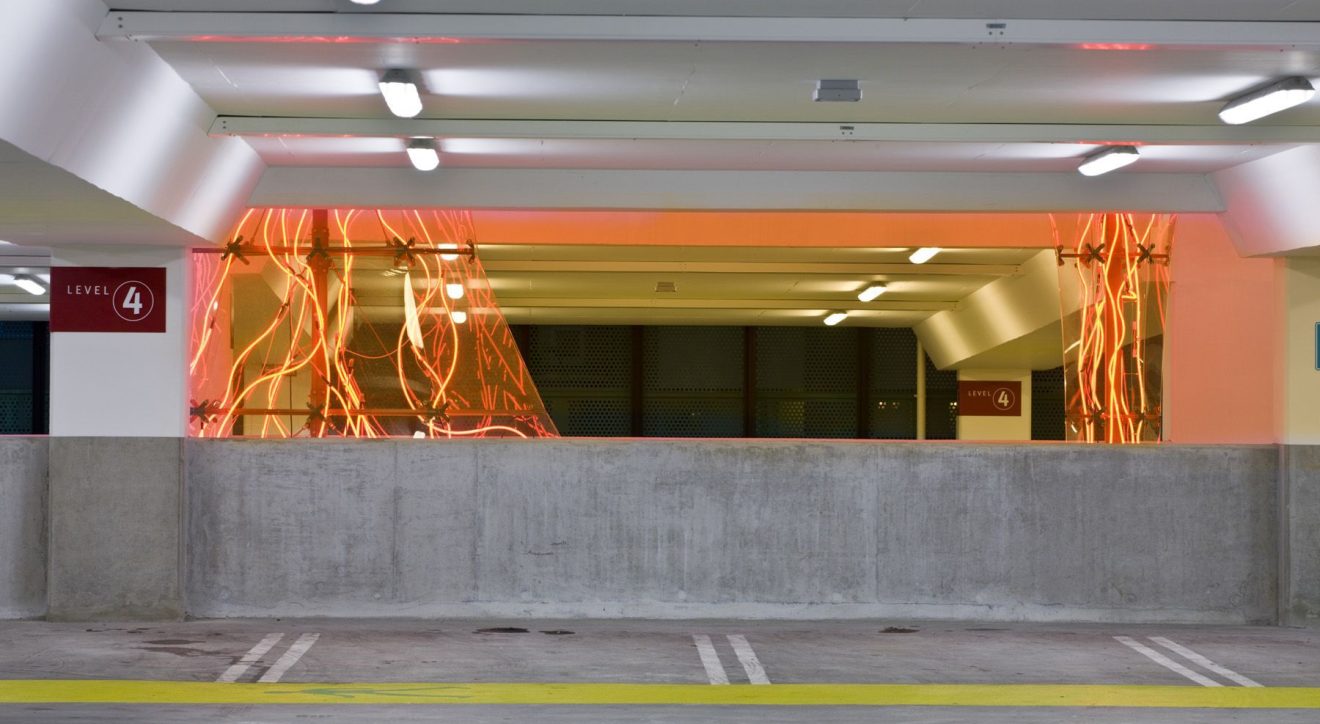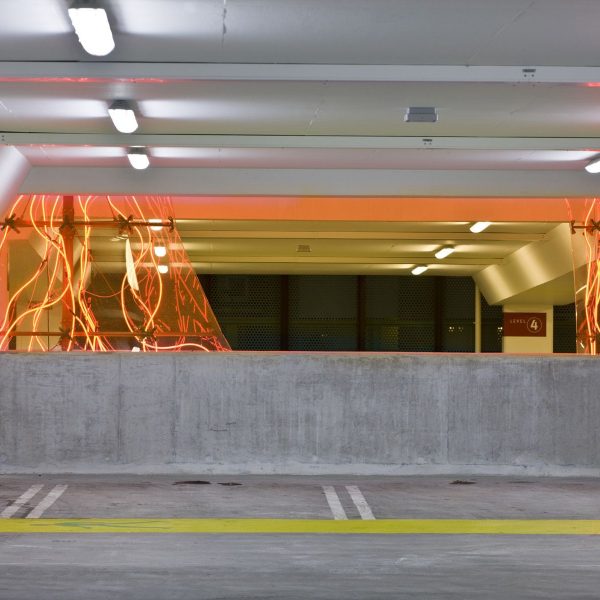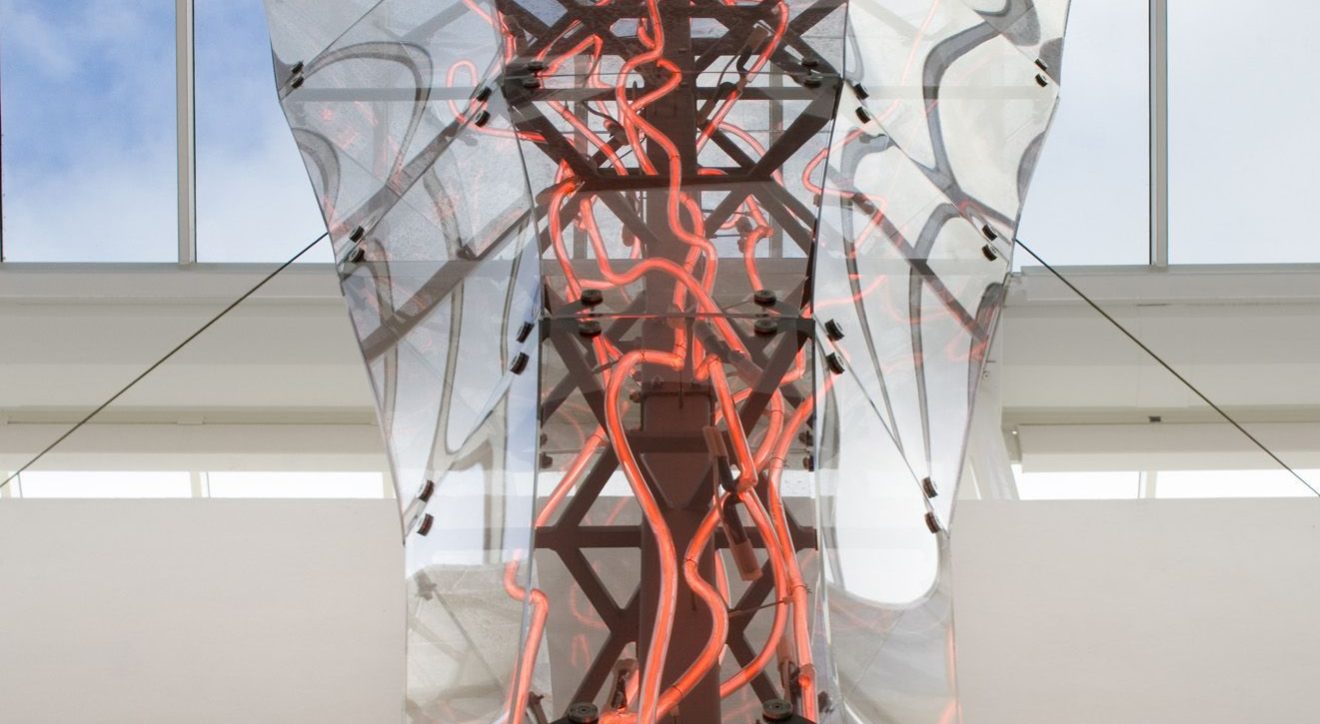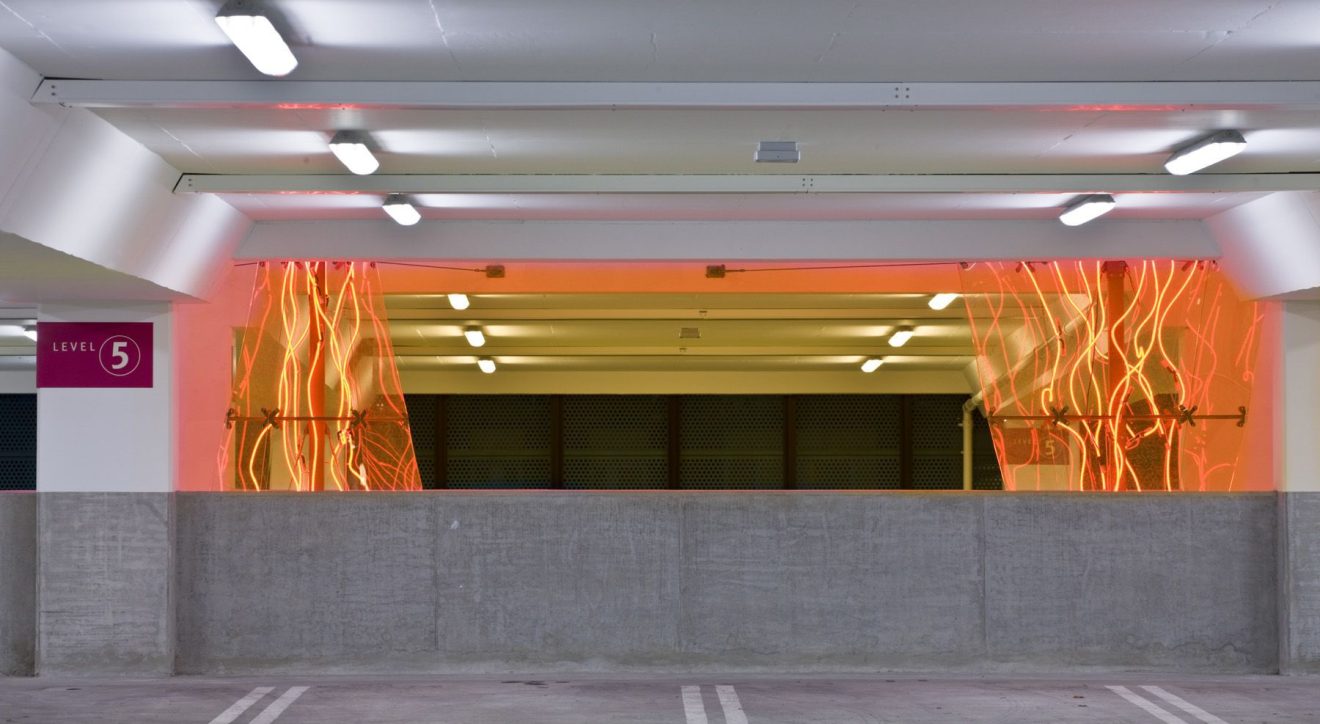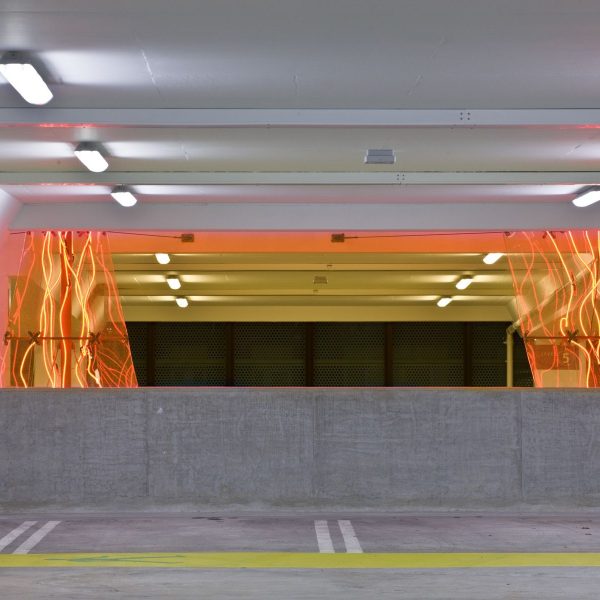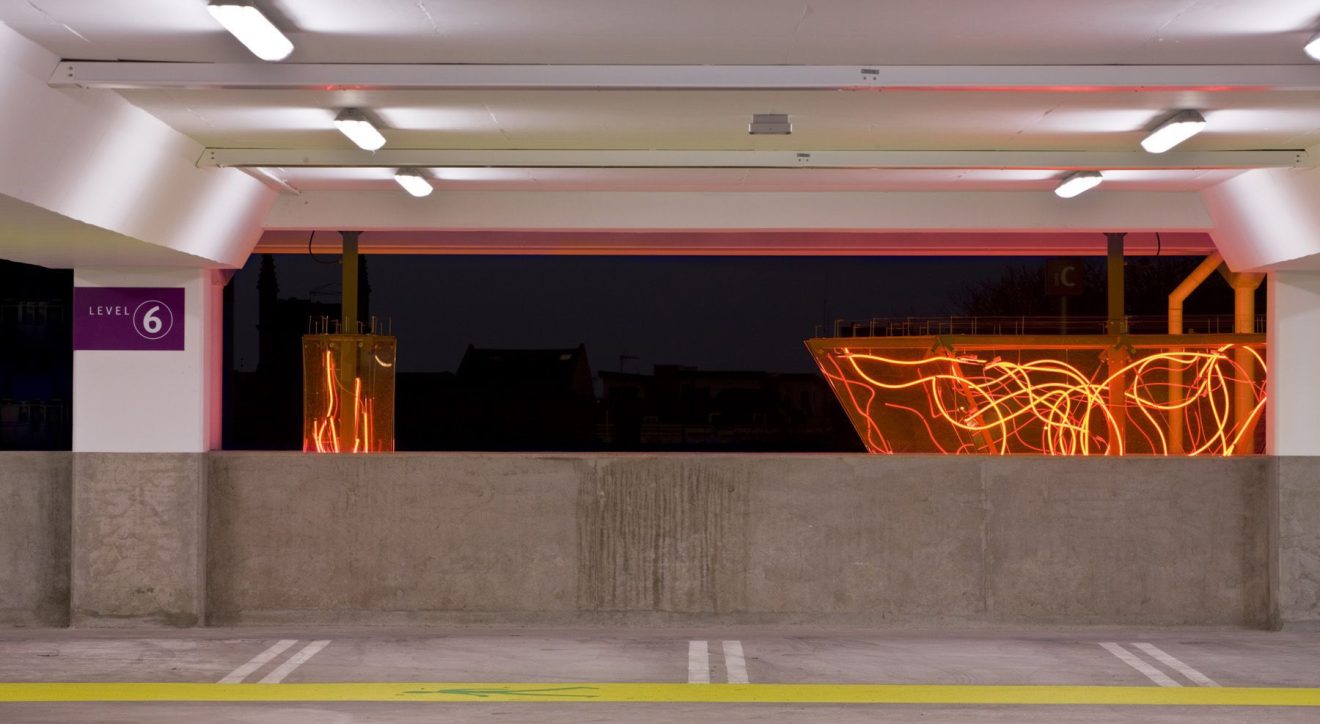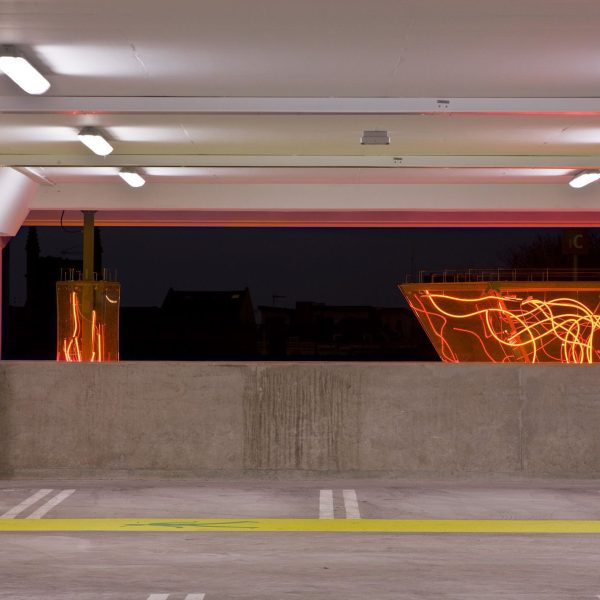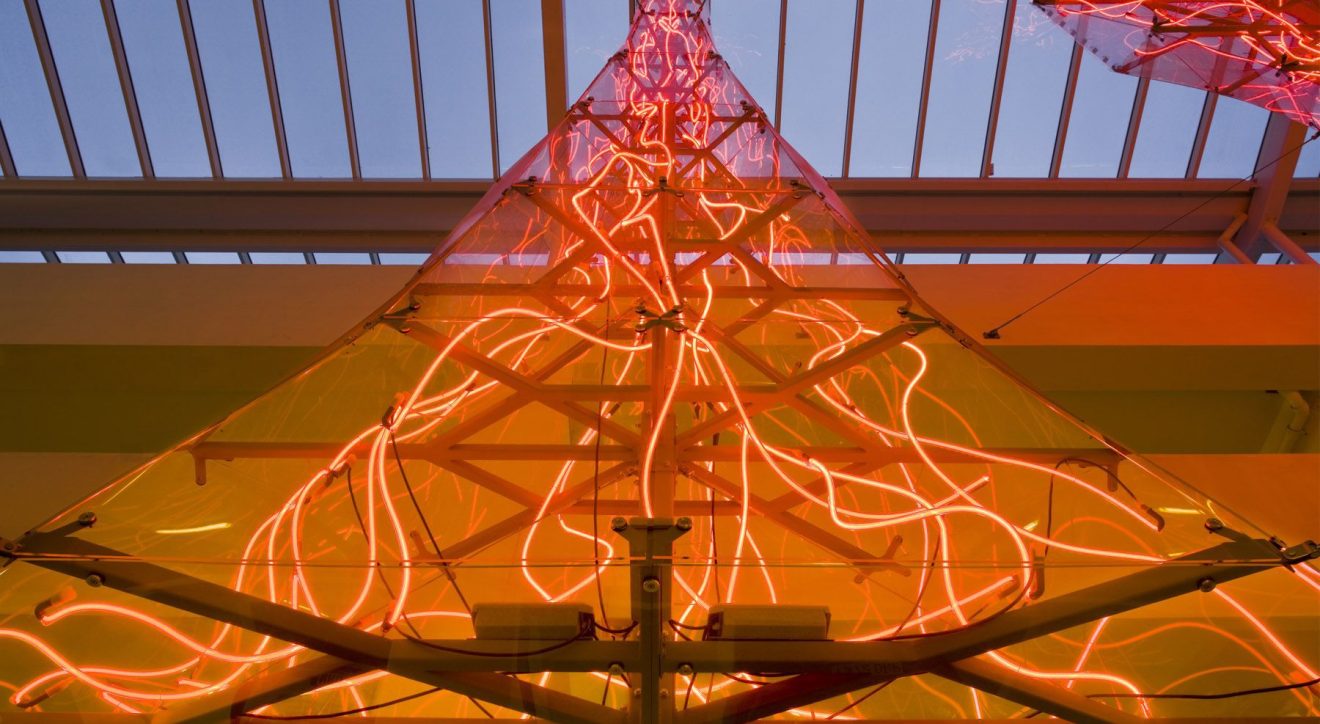
Synopsis
Cabot Circus is a shopping centre adjacent to Broadmead shopping district which opened in September 2008, after a ten-year planning and building project costing £500 million. The Cabot Circus development contains shops, offices, a cinema, hotel and 250 apartments and covers a total of 139,350 m2 (1,500,000 sq. ft.) of floor space. As part of the development London based art consultants InSite Arts were commissioned to develop a permanent and temporary public art commissions programme which included Vong Phaophanit and Claire Oboussier ‘All the World is Two’.
Description
Vong Phaophanit and Claire Oboussier’s were commissioned to develop an artwork for the Cabot Circus car park. Their work, ‘All the World is Two’ takes the form of twin neon structures each measuring 10x10m and suspended within the car park’s central void. The work is composed of twelve red coloured, hand-moulded neon strands encased in acrylic. The viewer catches multiple glimpses through the apertures opening onto the void from each of the car park’s levels, providing a series of viewing points which frame a different composition. It is only when the viewer arrives at the avenue below that the work as a whole is revealed.
“Our point of departure for ‘All the World is Two’ was a kind of cavernous emptiness, that feeling an artist gets when he or she is alone in the studio, confronted with the proverbial blank sheet of paper. But this sheet of paper was vast and voluminous, an empty tank – the void at the centre of an inner city car park. So, ideas and images began to circulate: we liked the idea of introducing a sense of alien presence into the void, something unprocessed, a kind of antidote to the smartness of the surrounding designed and built environment. We wanted the work to have the capacity to generate multiple layers of metaphor and thereby transcend any narrative impulses. People should be able to engage with it visually, viscerally, and be accorded the same freedom we had been, to generate meaning from it. We made forays into the imagery of neurology and botany only to leave it behind and begin to imagine our own generative systems, homespun organisms of growth and connectivity.
The ‘twin figures’ began to materialise and they seemed to embody both sameness and difference: they were duplicates of each other, but inverted, and seemed to create both visual and discursive circulation. The fact that they were built of light (neon) challenged their separateness: where light meets light there is no border, no partition but instead a kind of symbiosis occurs: a discursive and aesthetic space or ‘void’ is opened up and out of the figures’ duality something else, ‘in between’ literally ‘comes to light’.
We spent hours playing with different juxtapositions of coloured neon, enjoying for a brief moment the idea of a blue/pink, girl/ boy thing, only to ditch them all and return to the ‘clear red’ we knew would literally fill the void, transforming it into a tank of limpid colour. The process of bringing All the World is Two into being was one of conceptual and material production. The void offered itself as a kind of specimen jar for an unknown, unnameable species. It was the vital vacuum for this generative process.”
Taken from an interview with the artists and Sarah Collicott, 2005. Text © Sarah Collicott, courtesy of InSite Arts.
Vong Phaophanit & Claire Oboussier
Based in London, Turner Prize Nominee (1993) Vong Phaophanit and Claire Oboussier have worked together for over 20 years. Their collaborative practice encompasses, films, books, large-scale installations and sculptural works.
In 1994 Phaophanit was awarded the DAAD fellowship in Berlin and they subsequently lived and worked there for a year during which time they produced a book ‘Atopia’. In 2008 they created the film ‘All that’s solid melts into air (Karl Marx)’ (collection of the Tate Gallery) as part of a pioneering art project in Luang Prabang, Laos (The Quiet in the Land). They have created a number of large-scale groundbreaking public commissions including ‘Outhouse’ (2004), a sculptural glass ‘abode’ for the collective use of local residents, sited within a public park for Liverpool Housing Action Trust.
Other recent key works in public space include neon installations such as, ‘Light Curtain’ for Hull Truck Theatre (2009), ‘All the World is Two’ for Cabot Circus in Bristol (2008), ‘Light of Day’ (2010) for the Neo-Natal Baby Unit at St Georges Hospital in London.
In the summer of 2011 Phaophanit and Oboussier completed ‘Mute Meadow’ on the banks of the River Foyle in Derry ~ Londonderry, a major public commission and the largest artwork in public space in Ireland. December 2011 saw the launch of ‘Coronium’ for Kilden, The New Performing Arts Centre in Kristiansand, Norway. More recently they have worked on a permanent laser installation for Weymouth Esplanade for the sailing Olympics in 2012 and a major new public sculpture commission ‘Urban Firefly’ for downtown Toronto in Canada.
In addition to their work within the public realm work has been exhibited at venues such as Tate Britain, Martin-Gropius-Bau, Berlin, National Gallery of Canada, Ottowa, IMMA, Dublin, Reina Sofia Museum, Madrid, the Shanghai Biennale, and the Void Gallery, Derry~Londonderry.
Text © Max Barnes, 2012
InSite Arts
InSite Arts is a public art organisation founded by Sarah Collicott and Sam Wilkinson in 2001. InSite Arts works in partnership with its clients to generate and deliver innovative and relevant public art and arts initiatives in diversity of scales and in a wide variety of media.
InSite Arts develop strategies and artworks and have commissioned a wide range of projects from temporary events to permanent installations, from the more intimately scaled art projects through to major landmark installations integrated into the public realm and architectural schemes.
At the heart of their work is our staunch commitment to commissioning artwork which will inspire and intrigue, which become a fundamental part of a successful building, development, town or city. This can only be achieved by working closely with and supporting artists and clients throughout the course of the art project/programme, through to installation. Successfully conceived and delivered public artworks draw inspiration from a thorough understanding of location, the potential ‘audience’, history of the site and the aspirations of client and design team.
"The ‘twin figures’ began to materialise and they seemed to embody both sameness and difference: they were duplicates of each other, but inverted, and seemed to create both visual and discursive circulation."from an interview with the artists and Sarah Collicott, 2005. Text © Sarah Collicott, courtesy of InSite Arts.

